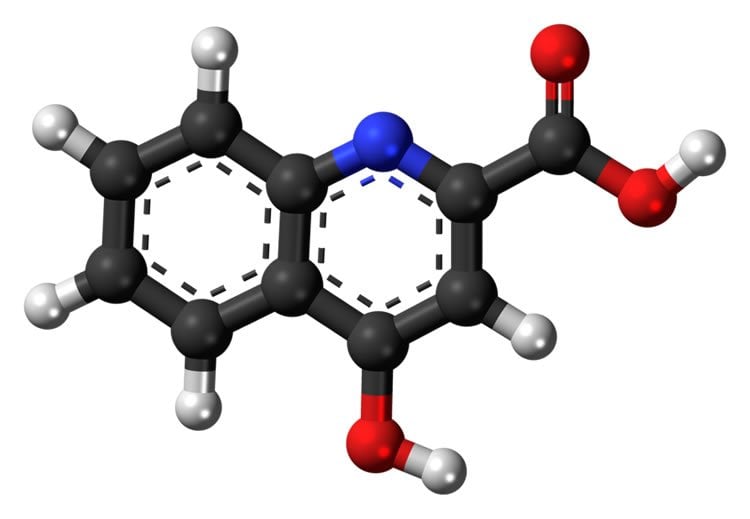Summary: Adjusting levels of KYNA can have a significant effect on schizophrenia symptoms, a new study reports.
Source: University of Maryland School of Medicine.
Research in mice could have implications for human brain disease.
A new study by University of Maryland School of Medicine researchers has found that in mice, adjusting levels of a compound called kynurenic acid can have significant effects on schizophrenia-like behavior. The study appeared in the latest issue of the journal Biological Psychiatry.
In recent years, scientists have identified kynurenic acid as a potential key player in schizophrenia. People with schizophrenia have higher than normal levels of kynurenic acid in their brains. KYNA, as it is known, is a metabolite of the amino acid tryptophan; it decreases glutamate, and research has found that people with this illness tend to have less glutamate signaling than people without the disease. Scientists have theorized that this reduction in glutamate activity, and therefore the higher KYNA levels seen in patients, might be connected with a range of symptoms seen in schizophrenia, especially cognitive problems.
For several years, Robert Schwarcz, PhD, a Professor in the Department of Psychiatry at the University of Maryland School of Medicine (UM SOM), who in 1988 was the first to identify the presence of KYNA in the brain, has studied the role of KYNA in schizophrenia and other neuropsychiatric diseases.
For the new study, Dr. Schwarcz and his team collaborated closely with scientists at the Karolinska Institute in Stockholm, Sweden, the University of Leicester in the United Kingdom, and KynuRex, a biotech company in San Francisco.
“This study provides crucial new support for our longstanding hypothesis”, Dr. Schwarcz said. “It explains how the KYNA system may become dysfunctional in schizophrenia.”

Dr. Schwarcz and his colleagues studied mice which were deficient in kynurenine 3-monooxygenase, or KMO, an enzyme that is crucial for determining the levels of KYNA in the brain. Specifically, lower KMO results in higher levels of KYNA. Interestingly, patients with schizophrenia have lower than normal brain levels of KMO, which may be linked to lower levels of glutamate.
The mice with lower levels of KMO showed impairments in contextual memory and spent less time than did a control group interacting with an unfamiliar mouse in a social setting. The low-KMO mice also showed increased anxiety-like behavior when put into a maze and other challenging settings. Since these behaviors are similar to behavioral traits in humans with schizophrenia, this suggests that KMO and KYNA may play a key role in the disease.
The new discovery has clinical implications as well. On its own, boosting glutamate on a large scale has serious side effects, including seizures and nerve cell death. Dr. Schwarcz and his colleagues propose that modifying KYNA could adjust glutamate more precisely. In recent years, he and his collaborators have in fact shown that a reduction in KYNA improves cognition in animals that have cognitive deficits similar to those seen in schizophrenia. Because this mechanism is indirect, it seems not to trigger the same side effects that directly boosting glutamate does. His UM SOM team is now investigating compounds that might produce the same results in humans.
Source: David Kohn – University of Maryland School of Medicine
Image Source: NeuroscienceNews.com image is in the public domain.
Original Research: Abstract for “Adaptive and Behavioral Changes in Kynurenine 3-Monooxygenase Knockout Mice: Relevance to Psychotic Disorders” by Sophie Erhardt, Ana Pocivavsek, Mariaelena Repici, Xi-Cong Liu, Sophie Imbeault, Daniel C. Maddison, Marian A.R. Thomas, Joshua L. Smalley, Markus K. Larsson, Paul J. Muchowski, Flaviano Giorgini, and Robert Schwarcz in Biological Psychiatry. Published online December 16 2016 doi:10.1016/j.biopsych.2016.12.011
[cbtabs][cbtab title=”MLA”]University of Maryland School of Medicine “Chemical Switch That May Decrease Schizophrenia Symptoms Discovered.” NeuroscienceNews. NeuroscienceNews, 7 February 2017.
<https://neurosciencenews.com/schizophrenia-kyna-psychology-6074/>.[/cbtab][cbtab title=”APA”]University of Maryland School of Medicine (2017, February 7). Chemical Switch That May Decrease Schizophrenia Symptoms Discovered. NeuroscienceNew. Retrieved February 7, 2017 from https://neurosciencenews.com/schizophrenia-kyna-psychology-6074/[/cbtab][cbtab title=”Chicago”]University of Maryland School of Medicine “Chemical Switch That May Decrease Schizophrenia Symptoms Discovered.” https://neurosciencenews.com/schizophrenia-kyna-psychology-6074/ (accessed February 7, 2017).[/cbtab][/cbtabs]
Abstract
Adaptive and Behavioral Changes in Kynurenine 3-Monooxygenase Knockout Mice: Relevance to Psychotic Disorders
Background
Kynurenine 3-monooxygenase converts kynurenine to 3-hydroxykynurenine, and its inhibition shunts the kynurenine pathway—which is implicated as dysfunctional in various psychiatric disorders—toward enhanced synthesis of kynurenic acid, an antagonist of both α7 nicotinic acetylcholine and N-methyl-D-aspartate receptors. Possibly as a result of reduced kynurenine 3-monooxygenase activity, elevated central nervous system levels of kynurenic acid have been found in patients with psychotic disorders, including schizophrenia.
Methods
In the present study, we investigated adaptive—and possibly regulatory—changes in mice with a targeted deletion of Kmo (Kmo–/–) and characterized the kynurenine 3-monooxygenase–deficient mice using six behavioral assays relevant for the study of schizophrenia.
Results
Genome-wide differential gene expression analyses in the cerebral cortex and cerebellum of these mice identified a network of schizophrenia- and psychosis-related genes, with more pronounced alterations in cerebellar tissue. Kynurenic acid levels were also increased in these brain regions in Kmo–/– mice, with significantly higher levels in the cerebellum than in the cerebrum. Kmo–/– mice exhibited impairments in contextual memory and spent less time than did controls interacting with an unfamiliar mouse in a social interaction paradigm. The mutant animals displayed increased anxiety-like behavior in the elevated plus maze and in a light/dark box. After a D-amphetamine challenge (5 mg/kg, intraperitoneal), Kmo–/– mice showed potentiated horizontal activity in the open field paradigm.
Conclusions
Taken together, these results demonstrate that the elimination of Kmo in mice is associated with multiple gene and functional alterations that appear to duplicate aspects of the psychopathology of several neuropsychiatric disorders.
“Adaptive and Behavioral Changes in Kynurenine 3-Monooxygenase Knockout Mice: Relevance to Psychotic Disorders” by Sophie Erhardt, Ana Pocivavsek, Mariaelena Repici, Xi-Cong Liu, Sophie Imbeault, Daniel C. Maddison, Marian A.R. Thomas, Joshua L. Smalley, Markus K. Larsson, Paul J. Muchowski, Flaviano Giorgini, and Robert Schwarcz in Biological Psychiatry. Published online December 16 2016 doi:10.1016/j.biopsych.2016.12.011






